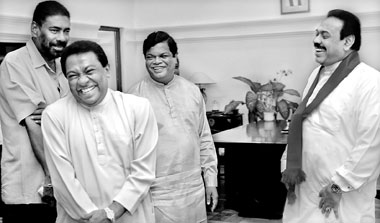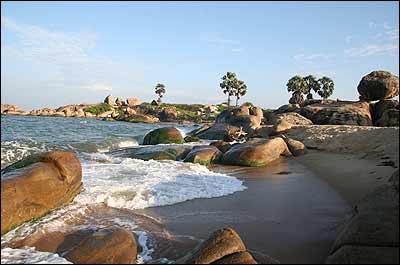Sri Lanka wasn’t short of help in the aftermath of the tsunami that hit the country more than three and a half years ago. Millions of people were affected, a lucky few losing no more than worldly possessions in the waves, while so many others saw their loved ones washed away forever, and the disaster moved those watching it unfold from afar to donate an unprecedented amount of money towards the recovery of survivors. Governments gave even more. Sri Lankans got an inkling of why this extraordinary outpouring of assistance didn’t result in well-being for everybody when a leading donor completed its flagship project and a new bridge was opened at Arugam Bay.
Pledges from overseas for the relief and reconstruction effort amounted to about $3.3 billion. Whether this all materialised is open to debate, but more important is what happened to the funds that did make it over here.
People aren’t all doing well. Newspapers occasionally carry reports of survivors who are still living in temporary accommodation or even on the streets, and a surprising number of those who were fortunate enough to benefit from a shelter scheme appear to have seen their new homes deteriorate to the point of being almost unliveable within a matter of months. Housing clearly isn’t the only difficulty. Livelihood programmes were infamous for their tendency to rely on giving away a random number of sometimes rather inappropriate items to the most obvious recipients while having no overall plan for the development of the affected sectors of the economy. Sri Lanka has probably achieved rather more than some of the other countries that were struck by the tsunami, but there are still plenty of issues waiting to be resolved over three and a half years later.
The $3.3 billion sounded like it was going to be more than enough to do the job. President Kumaratunga spoke enthusiastically on many occasions about the opportunity that such a level of international aid presented for developing the country in addition to ensuring the recovery of the affected people, and Bill Clinton was but one of the foreign voices who chimed in with inspirational words on what he was keen to refer to as building back better. It just doesn’t seem to have happened that way.
Price erexin-v Blame is popularly put on corruption. It has undoubtedly played a part but not necessarily the major role in what has gone wrong.
Non-Governmental Organisations are certainly another relevant target. Approximately $1 billion out of the total amount of assistance is said to have arrived via such channels, but much has already been said on this subject. Non-Governmental Organisations certainly didn’t spend all of their money wisely and they also managed to create a thoroughly unproductive culture of dependency wherever they set foot.
The Arugam Bay bridge has a different but equally useful story to relate. The United States Agency for International Development made the replacement of this bit of infrastructure the centrepiece of its support for the country after the tsunami and spent some $10.6 million. A total of $134.5 million was allocated as official aid by the United States. Other projects included the installation of a new water supply system, the reconstruction of ten vocational schools, the development of three fisheries harbours and the implementation of a coastal management programme. The United States Agency for International Development gave the contract for all of these projects to an American company by the name of CH2M Hill.
The United States claimed that it all exactly conformed to the expectations of survivors. Its press release on the occasion of the ceremonial opening last week professed to have held a large number of meetings with local people and community representatives in order to work everything out. Participation is a slippery concept. Arugam Bay residents might not have had much to say about what was described as a state-of-the-art design involving a composite of steel girders and concrete panels that hadn’t ever been used in this country but is often employed in the United States. The United States Agency for International Development reassured them and the rest of us that it was both less expensive and faster to build. Comparisons require a bit more information than that. The $10.6 million and three and a half years might not have sounded so wonderful if it referred to the bailey bridge that was installed in the same location within a couple of months and at minimal cost by the Indian Army.
Arugam Bay inhabitants clearly weren’t given a choice between spending on extras like guardrails and lights or something else unconnected with the bridge, and they didn’t have the chance to say that they’d rather use the whole sum on other projects and continue to use the perfectly serviceable existing infrastructure for a while. The United States thus ensured that a small town in a remote area ended up with something that wouldn’t look out of place in downtown New York.
Economic growth was brought into the debate as the ultimate excuse. The United States claimed that the bridge would help the town to retain its status as a tourist attraction and boost the local economy by providing easier access to the sixty or more hotels in Arugam Bay. Around 5,000 people and 1,400 vehicles are expected to cross the lagoon per day. Arugam Bay natives might have pointed out that visitors were already travelling along the road some few kilometres to the interior and indeed going across the bailey bridge set up by the Indian Army. Symbolism surely isn’t a reasonable explanation for inflated expenditure in an area with so much poverty even before the tsunami and it isn’t clear why anybody would expect vastly increased numbers of holidaymakers to turn up just because it is now a little bit easier to get from Pottuvil to Panama.
Infrastructure doesn’t magically increase economic growth. East Germans can surely testify to this having seen their prospects decline and unemployment increase following a major investment drive after their reunification with the West. Examples simply proliferate on this issue.
The United States boasted that the project had at least provided jobs for the survivors. Eighty percent of the work was done by local people, but we need not waste time wondering whether this also amounted to four fifths of the wages. The American company brought their own employees to design the bridge, and an Indian company was subcontracted to supervise the masons, carpenters and others who undertook the construction. Engineers and management staff aren’t exactly in short supply in this country, yet many of these salaries and their associated company fees went straight out of the economy to India and the United States. Indonesian companies provided much of the prefabricated material needed for this particular design, so still more money went overseas. Technology transfer was supposed to be an important aspect of the project, and employees were said to have learnt a few new skills from the experience, but this might not be very useful if nobody is planning any more state-of-the-art bridges in Ampara.
Sri Lankans might wonder who actually got what they wanted in Arugam Bay. The United States is renowned for pursuing its own interests through the foreign aid it offers. Around 70% of its funds are officially tied to the purchase of goods and services from its home companies. That’s an annual average of about $7 billion. The United States isn’t the only country to do this, of course. Nine out of ten donors make at least some of their aid conditional in this way, and almost half of all aid is so affected, while the value of what is given would increase by about one third if they didn’t attach these kinds of strings. The Arugam Bay bridge was actually subject to a competitive bidding process in which firms from almost every country were eligible to participate. The United States Agency for International Development made it much more likely that one of its own corporations would end up winning the contract by making their entire tsunami programme a single undertaking with cost considered only at a later stage in the selection process.
(Coincidentally, CH2M Hill is very well-connected in Washington. It contributed the most of all construction companies to political campaigns during the Presidential, House of Representatives and Senate elections of 2004, of which 70% went to the Republican Party. The company proceeded to win a number of multi-billion dollar no-bid contracts for rebuilding work in both Iraq and New Orleans.)
The $3.3 billion promised to this country to rebuild after the tsunami starts to look a bit feeble if we bear in mind that considerable amounts ended up being spent in this way. The Arugam Bay bridge is surely not an exceptional case. Money flowed out of local communities almost as fast as it was poured in. Benefits did accrue to the survivors but many opportunities were lost as well. Aid turns out to be a rather misleading term. It may come from well-meaning people, but there is something amiss with the systems that get the money from them to the intended beneficiaries. State donors are as much to blame as Non-Governmental Organisations. Sri Lanka has plenty of evidence of that.


 President Mahinda Rajapaksa is moving strategically to win the two provincial council elections. He has the political acumen and versatility to convince the electorate that the UPFA government is doing the best for Sri Lanka as far as the economy and the war are concerned.
President Mahinda Rajapaksa is moving strategically to win the two provincial council elections. He has the political acumen and versatility to convince the electorate that the UPFA government is doing the best for Sri Lanka as far as the economy and the war are concerned.







 Arugam Forum
Arugam Forum Arugam Photo Galleries on Picasa
Arugam Photo Galleries on Picasa Old Website
Old Website Press Coverage
Press Coverage Surf Forecast for Arugam Bay
Surf Forecast for Arugam Bay
TODAY’s Comments